Kit for detecting deafness susceptibility genes
A susceptibility gene and kit technology, applied in the field of detection of deafness susceptibility genes, can solve the problems of indeterminacy, time-consuming and laborious, and achieve the effects of fast detection turnaround time, reduced sample manipulation, and high sensitivity
- Summary
- Abstract
- Description
- Claims
- Application Information
AI Technical Summary
Problems solved by technology
Method used
Image
Examples
Embodiment 1
[0053] The design of embodiment 1 primer
[0054] (1) PCR amplification primers:
[0055] According to the selected deafness susceptibility genes, the amplification primers specific for each deafness susceptibility gene are designed, and the amplification primers can amplify a DNA sequence including the mutation site. The amplification primer has at least 15 bases at the 3' end that completely match the gene sequence it is targeting, and has a 10 base (acgttggatg) tag sequence at the 5' end to distinguish the amplification primer from the extension primer.
[0056] (2) Mass spectrometry extension primer:
[0057] Design an extension primer, the length of the extension primer is 15-28 bases, and its 3' end is located at the previous base of the relevant mutation site, and the extension primer only extends one base when the extension reaction occurs, and the extended The base is the relevant mutation site.
[0058] The information on the mutation site of the deafness suscepti...
Embodiment 2
[0069] sample preparation
[0070] Sampling method: Use a cotton swab to wipe the inside of the cheek 15 times.
[0071] DNA was extracted (extracted using Tiangen DNA kit, and the operation method was extracted according to the instructions of the kit).
Embodiment 3
[0072] The detection method of embodiment 3 deaf susceptibility genes
[0073] (1) Using the DNA extracted in Example 2 as a template, use the PCR amplification primers in Example 1 to amplify by PCR to obtain the target sequence amplification product. See Table 4 for the PCR amplification reaction system. Among them, all reagents were purchased from Agena Bioscience.
[0074] Table 4: PCR amplification reaction system
[0075]
[0076] The PCR reaction conditions were 94°C for 2 minutes; denaturation at 94°C for 30 seconds, annealing at 56°C for 30 seconds, extension at 72°C for 1 minute, and a total of 45 cycles of amplification; the final extension at 72°C for 5 minutes. The DNA extracted in 2 was used as the DNA template for PCR amplification. At the same time, sterile double distilled water was used as a negative control. The control sample and the test sample were reacted and tested according to the same reaction process to verify the validity of the test.
[007...
PUM
 Login to View More
Login to View More Abstract
Description
Claims
Application Information
 Login to View More
Login to View More - R&D
- Intellectual Property
- Life Sciences
- Materials
- Tech Scout
- Unparalleled Data Quality
- Higher Quality Content
- 60% Fewer Hallucinations
Browse by: Latest US Patents, China's latest patents, Technical Efficacy Thesaurus, Application Domain, Technology Topic, Popular Technical Reports.
© 2025 PatSnap. All rights reserved.Legal|Privacy policy|Modern Slavery Act Transparency Statement|Sitemap|About US| Contact US: help@patsnap.com



